Brain Lesions – Symptoms, Causes, Types and Treatment


A brain lesion is a damaged area in the brain tissue. It can happen due to a traumatic injury, infection, or destruction of the brain cells. The initial stages of a brain lesion may not show any symptoms. However, as the lesions progress over time, they can cause mental and physical changes. There are numerous types of brain lesions that can range from large to small, few to many, and from relatively harmless to life threatening.
What are brain lesions?
Brain lesions are a type of damage or injury to your brain. These can occur in any part of your brain. They can be caused by trauma, disease, or may have been present since birth.
Each type of brain lesion is different. In some cases, it appear only in a specific part of your brain. In others, they can affect a larger portion of the brain. Some are relatively harmless, while others can be severe and life-threatening.
Request an appointment at Apollo Hospitals
What are the symptoms of brain lesions?
You may experience symptoms depending on the location, severity, and type of brain lesion. Headaches are usually the first symptoms you develop when you get brain lesions. You may experience a sudden headache which may worsen over time.
Along with headache, some of the other symptoms that you can experience are:
- Lack of appetite, nausea, and vomiting
- Lack of concentration
- Memory loss or confusion
- Pain or stiffness in the neck
- Seizures
- Impaired hearing, delayed speech, or blurred vision
- Involuntary movement of body parts
When to see a doctor
If you are experiencing the symptoms mentioned above, immediately seek medical assistance. An early diagnosis and treatment can help you avoid the risk of severe complications in the future.
Request an appointment at Apollo Hospitals
Call 1860-500-1066 to book an appointment
What are the causes of brain lesions?
The following are some possible causes:
- Ageing
- Vascular conditions such as a stroke, cerebral artery aneurysms, or high blood pressure
- Trauma to the brain
- Infections in the brain
- Brain tumors
- Poor lifestyle habits such as excessive alcohol consumption and cigarette smoking
What are the different types of brain lesions?
- Abscesses: Abscesses are areas of infection in the brain, such as inflamed tissue or pus. Although not very common, abscesses can be life-threatening.
- Cerebral infarction: Infarction means the death of tissue. Cerebral infarction is a type of brain lesion where a cluster of brain cells die due to an insufficient oxygen supply.
- Multiple sclerosis: In this condition, the immune system attacks and damages the nerves that line the spinal cord and brain. The lesions make it difficult for communication to take place between the brain and the body.
- Arteriovenous malformations: Arteriovenous malformations or AVMs are brain lesions that occur during the early stages of development in an individual. The arteries and veins of the brain grow tangled and get connected by tube-like structures known as fistulae.
In such cases, the arteries grow weaker as compared with normal arteries. The blood flow takes place from the arteries through the fistulae and to the veins. This causes veins to become enlarged. Consequently, these fragile blood vessels are at an increased risk of rupturing and leaking blood into the brain.
- Tumors: Tumuors are cluster of cells whic grow abnormally from normal tissue. Some tumours in the brain are benign (non-cancerous) and others are cancerous. They could start in your brain, or they may spread from other parts of the body (metastatic). They might grow fast or they may remain stable.
What are the treatment options available for brain lesions?
Considering the causes, symptoms, location, and severity of your brain lesions, the doctor will recommend a treatment plan for you. The goals of the treatment plan may be to remove the lesions from the brain altogether or, in severe cases, relieve the symptoms to improve the quality of life.
The standard treatment options include:
Medications
The doctor may prescribe medications such as antibiotics or antimicrobials. These will help fight the infections.
Chemotherapy and radiation therapy
Chemotherapy uses drugs and chemicals, while radiation therapy uses beams of intense energy. These treatment options will help fight cancerous brain lesions.
Surgery
In severe cases, the doctor may recommend surgical removal of the lesions. With advanced surgical approaches, even lesions that are hard to reach inside the brain can be treated.
Conclusion
Brain lesions develop in different forms, which can make their diagnosis difficult. This is why it is essential that you consult with a doctor even if you experience mild symptoms. In most cases of brain lesions, there are no visible symptoms. But a diagnosis can help detect brain lesions at the earliest and avoid complications in the future.
Frequently Asked Questions (FAQs)
What is the difference between brain lesions and brain tumors?
Brain tumors are a type of brain lesions that may be benign or malignant. The most common type of benign brain tumor is meningiomas, and malignant brain tumor is glioblastoma multiforme.
What do brain lesions look like on an MRI?
Brain lesions appear as abnormal light or dark tiny spots, not characteristic of a normal brain MRI.
How Are the Brain Lesions Diagnosed?
The methods used to diagnose and identify brain lesions depend on the symptoms. In most of the cases, MRI and CT imaging studies help identify the size, location and characteristics of the lesions. Blood and other laboratory tests may also be done to look for signs of infection.
© Copyright 2024. Apollo Hospitals Group. All Rights Reserved.
 +91 8069991061
Book Health Check-up
+91 8069991061
Book Health Check-up







